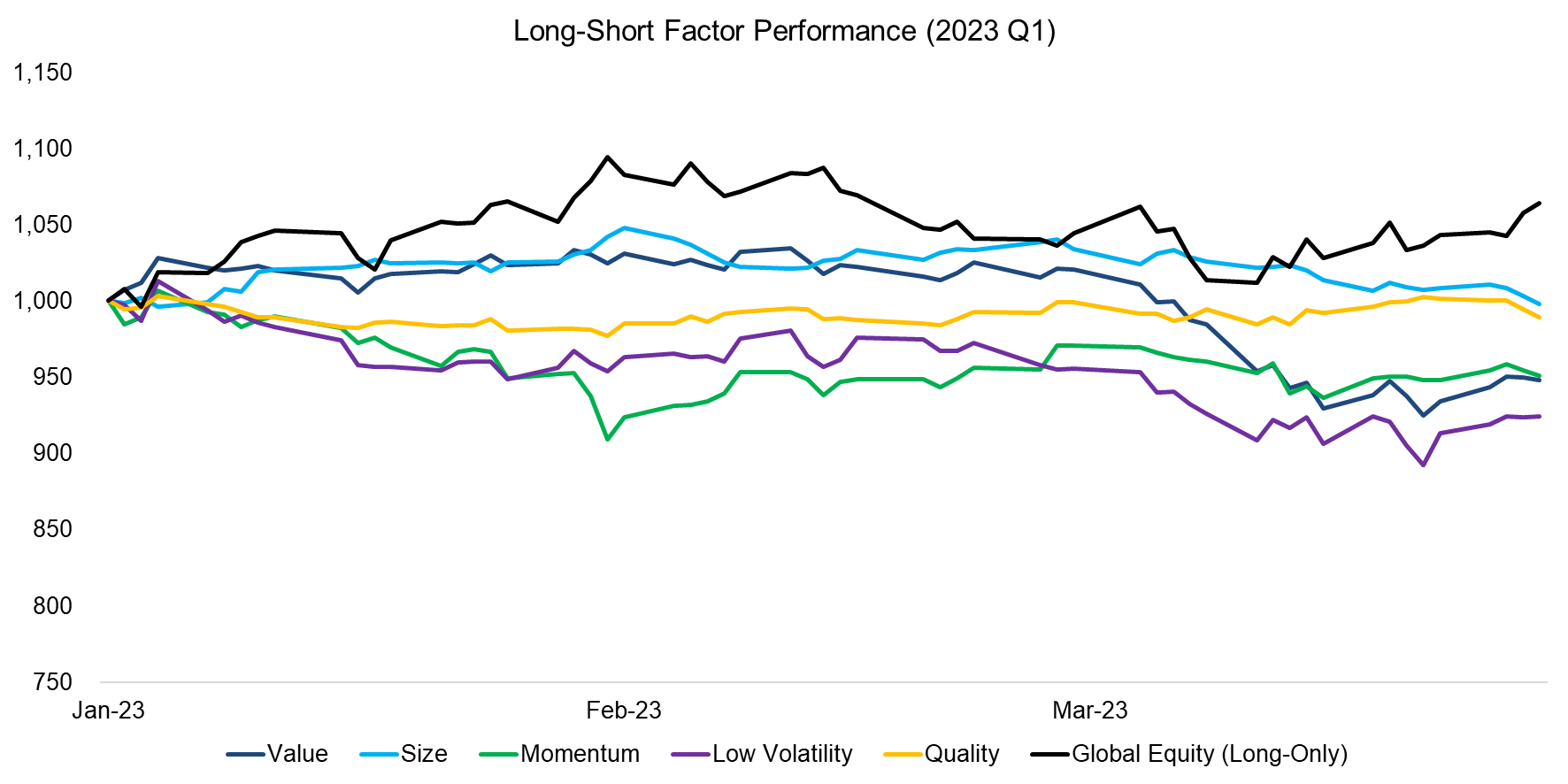Factor Olympics 2023 Q1
And the winner is…
April 2023. Reading Time: 10 Minutes. Author: Nicolas Rabener.
SUMMARY
- After a great 2022 for factor investing, this year has started negatively for all traditional factors
- Perhaps this can be attributed to a revival of the growth theme as growth ETFs have outperformed again
- Size performed best, low volatility worst
INTRODUCTION
We present the performance of five well-known factors on an annual basis for the last 10 years. Specifically, we only present factors where academic research supports the existence of positive excess returns across market cycles and asset classes.
METHODOLOGY
Our factors are created by constructing long-short beta-neutral portfolios of the top and bottom 30% of stocks. Only stocks with a minimum market capitalization of $1 billion are included. Portfolios rebalance monthly and transactions incur 10 basis points of costs.
FACTOR OLYMPICS: GLOBAL RETURNS
The table below shows the long-short factor performance for the last 10 years ranked top to bottom. The global series is comprised of all developed markets in Asia, Europe, and the US. Aside from displaying the factor performance, the analysis highlights the significant factor rotation in terms of profitability from one year to the next, highlighting the benefits of diversified exposure.
Last year was great for factor investing as most factors generated attractive returns. An equal-weighted multi-factor portfolio was up 7.5%, which was the best return over the last decade. Only small caps performed poorly as evidenced by the negative size factor.
In contrast, the first quarter of 2023 started exceptionally poorly for factor investing as all five factors produced negative returns with low volatility and cheap stocks performing worst. Small caps only marginally underperformed large caps. It is an almost perfect reversal of fortunes.

Source: Finominal
TRENDS IN GLOBAL FACTOR PERFORMANCE
Observing the trends in performance of the first quarter of 2023 highlights that the value and low volatility factors seem to have been positively correlated, similar to the size and quality factors.
Most of the negative performance can be attributed to March as the first two months were rather flattish. This performance can perhaps be attributed to most of these factors representing anti-growth stock bets, where the interest in the latter increased recently again. Investors are speculating that inflation has peaked and central banks might switch from tightening to easing policies to stimulate economic growth, which may favor more risky investments like growth stocks and cryptocurrencies again.

Source: Finominal
PERFORMANCE OF LONG-SHORT MULTI-FACTOR PRODUCTS
There are only a few liquid alternative mutual funds and ETFs that provide exposure to factors in the long-short format as seen in academic research. Given the poor performance of factor investing in recent years, many products were liquidated.
We compare the performance of four surviving products to that of the theoretical equal-weighted multi-factor portfolio. We observe that the trends in performance were similar, except for the European multi-factor equity fund (MKTN) which exhibited flat returns with extremely low volatility.
The key difference is that the global multi-factor equity fund (QMNIX) and multi-factor cross-asset fund (QSPRX), which are both managed by AQR, have significantly higher volatility, which is explained by using leverage in portfolio construction.

Source: Finominal
SMART BETA EXCESS RETURNS
Although investors should allocate to factors constructed as long-short portfolios given that these offer high diversification benefits, most invest via long-only smart beta ETFs (read Smart Beta vs Alpha + Beta). Following the money, we highlight the excess returns generated from investing in smart beta ETFs in the US, which represents a universe of 160+ products and approximately $800 billion of assets under management. We also show the performance of the growth factor, which is popular with investors but is not associated with positive excess returns over time (read What Are Growth Stocks?).
The returns can be different as long-short factor portfolios are constructed beta-neutral, i.e. there is a short portfolio and leverage is used to achieve beta-neutrality, and stocks are typically weighted equally. Smart beta ETFs are long-only and mostly weight stocks by their market capitalization.
We observe that the traditional factors namely value, size, momentum, low volatility, and quality generated negative excess returns in their smart beta versions, which broadly speaking mirrors the trends in long-short factors in the first quarter of 2023. As expected, growth-focused smart beta ETFs outperformed, a reversal of their performance from last year.

Source: Finominal
FACTOR CORRELATIONS
The correlation matrix below highlights the global one-year factor correlations based on daily returns. The current correlations highlight a scenario that does not occur frequently as value, momentum, and low volatility factors are highly correlated. Interestingly this largely seems to apply to large caps as the size factor is negatively correlated to those three factors (read Factors: Correlation Check).

Source: Finominal
FURTHER THOUGHTS
The performance of factors has been poor in the first quarter of 2023, however, it can be argued that it is an unusually pleasant time to select stocks based on factors. Who does not like holding stocks that are cheap, feature low volatility and high-quality characteristics, and have been outperforming?
RELATED RESEARCH
Shorting Lousy Stocks = Lousy Returns?
Outperformance Ain’t Alpha
Improving the Odds of Value Investing
The Value Factor’s Pain: Are Intangibles to Blame?
Smart Beta vs Alpha + Beta
How Painful Can Factor Investing Get?
ABOUT THE AUTHOR
Nicolas Rabener is the CEO & Founder of Finominal, which empowers professional investors with data, technology, and research insights to improve their investment outcomes. Previously he created Jackdaw Capital, an award-winning quantitative hedge fund. Before that Nicolas worked at GIC and Citigroup in London and New York. Nicolas holds a Master of Finance from HHL Leipzig Graduate School of Management, is a CAIA charter holder, and enjoys endurance sports (Ironman & 100km Ultramarathon).
Connect with me on LinkedIn or X.

